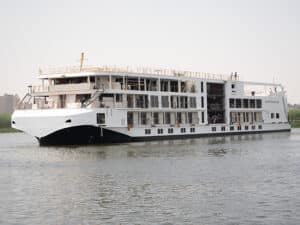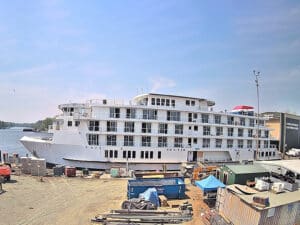
VIDEO: Cruising’s green agenda marks “concrete progress”
Written by Nick Blenkey
CLIA chairman Pierfrancesco Vago: “The cruise industry, as part of the broader maritime sector, is doing its part by building the future of cruise into our ships today.” [Photo:MSC Cruises]
The Cruise Lines International Association (CLIA) has released its 2023 Global Cruise Industry Environmental Technologies and Practices Report, saying that it shows concrete progress by the sector in advancing its green agenda. It has also released a new video underscoring the key steps that the industry is taking.
One thing that emerges is that cruising is very much on the same page as the rest of the shipping in the green technologies it is adopting.
CLIA cites 2023 order book data showing that cruise lines continue investment in new vessels with 44 new ships on order during the next five years, representing an investment of $62 billion since 2019. Of these new ships, 25 will be LNG-fueled and seven will be either methanol ready on delivery, or methanol capable.
CLIA says a number of alternative fuels pilot programs and trials are currently in place on cruise ships. In addition, an increasing number of vessels sailing and launching over the next five years will either use alternative fuels or will be able to incorporate zero carbon fuels when they become available. Cruise lines are also making other significant investments to reduce emissions at berth and at sea, including in shoreside power.
More cruise lines are diversifying energy solutions by incorporating multi-fuel engines, trialing fuel cell technology, wind (including solid sail) technology, as well as photovoltaic solutions and battery storage for power shaving.
Efficiency tracking systems are now in use on 171 CLIA-member ships, representing 60% of the global fleet, with many more systems planned.
Cruising’s green agenda sees lines pursuing fuel flexibility, investing today in propulsion technologies with conversion capabilities for the future—with 32 pilot projects and collaborative initiatives underway with sustainable fuel producers and engine companies.
“Cruise lines continue to transform the modern fleet to protect the oceans, air and destinations enjoyed by millions of passengers each year,” says CLIA president and CEO Kelly Craighead. “Our data shows a step change in the uptake of new environmental technologies by our cruise line members. Already today cruise lines are building the ships of the future which will run on new, more sustainable engine technologies. The introduction of these new technologies and the many pilot programs and trials in place reveal how the cruise industry is an innovator and early adopter of technologies that are helping us sail to a more sustainable future.”
Echoing sentiment across the shipping industry, CLIA says the availability of sustainable marine fuels remains essential to achieving the maritime industry’s decarbonization goals and underscores the need for governments to support research efforts to accelerate development of these fuels so that they are safe, viable and available for use.
Chairman of CLIA, and executive chairman of MSC Cruises, Pierfrancesco Vago said: “Achieving our collective sustainability ambitions requires substantial investment from the public and private sector. The cruise industry, as part of the broader maritime sector, is doing its part by building the future of cruise into our ships today. We need governments to support research efforts, as well as provide a clear and stable regulatory landscape, so that fuel suppliers and others can do the critical work needed.”
HIGHLIGHTS
You can see all the CLIA sustainability stats HERE. Here are some highlights:
Shoreside Electricity (SSE) Capability
Across the CLIA cruise-line member fleet, 120 ships (46% of the total and a 48% increase in the number of ships with SSE since 2022) are equipped to connect to shoreside electricity, with 86% of CLIA member ships (representing 95% of global passenger capacity) coming online between now and 2028 specified for shoreside electricity system.
Currently 32 ports (compared to 29 ports in 2022), representing fewer than 2% of the world’s ports, have at least one cruise berth with plug-in capability.
By 2028, more than 210 ships with shoreside power capability are expected, plus additional ships to be retrofitted with the capability, representing a total of 72% of ships and 74% of global passenger capacity.
In 2022, CLIA has announced that its ocean cruise line members have made a commitment that all ships calling at ports capable of providing shoreside power will be equipped to either use SSE by 2035 or be able to use alternative low-carbon technologies, as available, to reduce emissions in port.
As part of the EU’s Fit for 55 green program, by 2030, major ports in Europe will be required to have shoreside power, which will further accelerate the available port infrastructure investment in that region.
Advanced Wastewater Treatment Systems
Across the CLIA cruise-line member fleet, 202 ships (77% of the total), representing 80% of global passenger capacity (a 12% increase from 2022) are equipped with advanced wastewater treatment systems. These systems operate to a higher standard than shoreside treatment plants in many coastal cities.
All CLIA-member cruise line newbuild ships are specified for advanced wastewater treatment systems— which will bring the total to 242 ships, representing 80% of the fleet and 84% of global capacity.
In addition, since 2019, the number of ships with advanced wastewater treatment systems capable of meeting the more stringent standards of the Baltic Sea Special Area has increased 167%. Today, nearly one- third of CLIA member ships have this capability.
Renewable fuels and alternative energy sources
Within the CLIA member fleet, four ships sailing today use renewable biofuel as an energy source—and an additional four new-build ships are expected to be configured for renewable biofuels.
In addition, 24 ships have biofuel trials and two have synthetic carbon fuels trials.
Seven newbuild ships are anticipated to run on zero carbon fuels, including five ships envisioned to use green methanol and two envisioned to use green hydrogen.
15% of newbuild cruise ships entering service in the next five years are anticipated to be equipped with battery storage and/or fuel cells to allow for hybrid power generation.
LNG Fuel – As the cruise industry anticipates the transition to a future of sustainable, renewable fuels, several cruise ships are utilizing liquified natural gas (LNG). Ships designed with LNG engines and fuel supply systems are able to switch to bio or synthetic LNG in the future, with little or no modifications.
The 2023 report found 48% of newbuild capacity will be designed with LNG engines and fuel supply systems. These ships are part of a future generation of vessels that will be capable of running on renewable marine fuels once fuel providers are able to make them available at scale.



